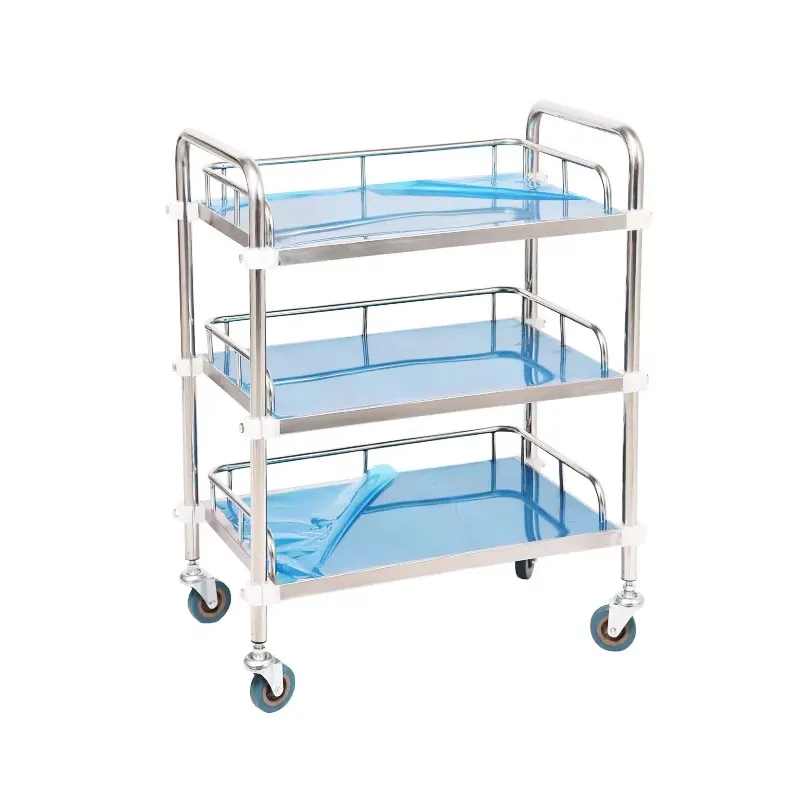Need an Instrument Trolley for Hospital—Durable & Sterile?
What to Look for in a Hospital Instrument Trolley (From Someone Who’s Spent Years on the Ward)
If you’re speccing carts for a surgical suite or a busy ED, you’ll quickly discover the rabbit hole goes deep. Here’s a practical walk-through centered on the Stainless Steel Instrument Trolley For Hospital Metal Medical Cart With Silent Castors—yes, the classic workhorse. For context, I’m linking the exact product I inspected: instrument trolley for hospital.

Industry snapshot (and why it matters)
Trends first: stainless is still king (304 in wards, 316 in corrosive or high-disinfection environments), noise-reduction has become non-negotiable, and hospitals increasingly want modular add‑ons instead of fixed carts. To be honest, the number of facilities asking for antistatic, non-marking wheels has jumped. Infection control teams also push for simple geometries—fewer dirt traps, easier wipe-downs.
Representative specifications (real‑world, not brochure-ware)
| Product name | Stainless Steel Instrument Trolley For Hospital Metal Medical Cart With Silent Castors |
| Origin | Zhouhu Village, Jizhou Zone, Hengshui City, Hebei Province, China (Brand: ZHAOFA; Model: available upon request) |
| Material | SUS304 (optional SUS316 in splash/saline zones); sheet gauge ≈1.0–1.2 mm, No.4 brushed finish |
| Shelves & rails | Two shelves with perimeter guard rails; rounded corners for easy cleaning |
| Castors | Silent, non-marking, twin-wheel; 4 pcs with 2 brakes (antistatic option) |
| Load capacity | Around 100–150 kg total (real-world use may vary by configuration) |
| Size | Common: ≈750×500×900 mm; customized footprints available |
Manufacturing/process flow (how it’s actually built)
- Materials: SUS304/316 plate to ASTM A240 or GB/T 3280.
- Cutting & forming: CNC shearing, bending; TIG welding with argon shielding.
- Finish: bead blast or No.4 brush; passivation; deburr; ultrasonic clean.
- Assembly: press-fit tube posts, guard rails, handle, and castors with thread-lock.
- Testing: dimensional check; caster roll test (e.g., 5–10 km endurance, internal); brake cycle test (≈2,000 cycles); wipe-down compatibility with hospital disinfectants.
- Service life: typically 5–10 years depending on grade, duty cycle, and cleaning chemistry.

Where it shines
OR back tables, ICU bedside procedures, endoscopy rooms, CSSD staging, pathology labs, even dental operatories. The instrument trolley for hospital format is popular because it’s simple, wipes clean fast, and the “silent” castors don’t wake the ward at 2 a.m. (many nurses mention this, half-joking, half-serious).
Customization checklist
- Steel grade (304 vs 316), shelf count, drawer modules, waste bins, IV pole, side baskets.
- Castor diameter, antistatic option, central brake, corner bumpers.
- Handle side, label holders, knock-down vs welded frame, edge lips (3- or 4-sided).
Vendor comparison (quick reality check)
| Vendor | Origin | QMS/Certs | Customization | Lead time |
|---|---|---|---|---|
| ZHAOFA (this model) | Hebei, China | ISO 9001/13485 status: available upon request | High—size, shelves, wheels, add‑ons | Typically 2–4 weeks (order-dependent) |
| Global Trading House A | Multi-source | Varies by factory | Medium | 3–6 weeks |
| EU OEM B | EU | ISO 13485 common | High, premium pricing | 4–8 weeks |
Testing, standards, and hygiene notes
- Material conformance: ASTM A240 (304/316). Corrosion checks often include ASTM B117 salt-spray benchmarks (e.g., ≥48 h, indicative).
- Quality systems: ISO 9001, ISO 13485 for medical device manufacturing environments.
- Cleaning: neutral detergent, then hospital-grade disinfectant; avoid prolonged chlorine pooling on welds; rinse and dry. WHO guidance is your north star.

Field notes (two quick scenarios)
1) Regional OR center swapped mixed carts for a standardized instrument trolley for hospital spec with silent castors—informal feedback suggested fewer patient sleep disruptions on night shifts.
2) Coastal dialysis unit moved to 316-grade versions; maintenance flagged fewer rust spots after six months in saline-heavy cleaning routines. Not scientific, but telling.
Quick buying tips
- Choose 316 for high-corrosion zones; 304 is fine elsewhere.
- Insist on documented load tests and caster brake cycle data.
- Ask for edge radii and weld quality photos—your infection control team will thank you.
Bottom line: a well-built instrument trolley for hospital is boring in the best way—quiet, cleanable, predictable. That’s exactly what you want when the ward is anything but.
Authoritative citations
- ASTM A240/A240M – Standard Specification for Chromium and Chromium-Nickel Stainless Steel Plate, Sheet, and Strip
- ISO 13485 – Medical devices — Quality management systems
- ASTM B117 – Standard Practice for Operating Salt Spray (Fog) Apparatus
- WHO – Cleaning and disinfection of environmental surfaces in health care



































